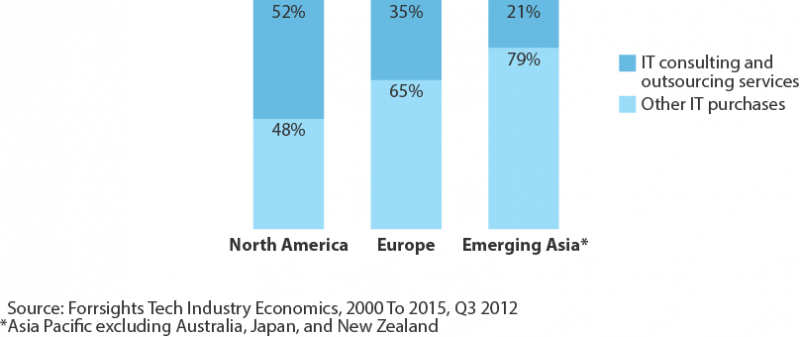Reconsider Outsourcing To Accelerate IT Maturity
Organizations in growth markets across Asia have not traditionally been heavy consumers of outsourcing services. Having lots of on-premises hardware still carries some prestige for local CIOs, particularly in China and India. The availability of relatively inexpensive IT staff in local markets has also helped them deliver acceptable service levels to the business. Until now, that is. The combination of quickly rising IT salaries, increased competition from regional and even global expansion, and growing demands among business stakeholders to more effectively engage customers has put pressure on CIOs to increase the performance of their organizations.

More and more CIOs I speak with are struggling with how best to effectively transform their IT capabilities and meet fast-changing business requirements. In particular, whether to embark on this transformation journey alone or leverage outsourcing partners. In a recent report, I profiled organizations in Asia that are leveraging external service providers to accelerate their IT maturation. One example is a manufacturer with 10,000 employees and operations across Asia that outsourced its entire IT infrastructure environment to improve and homogenize service levels. Another is a large Indian bank that outsourced its entire IT department to a service provider and improved its maturity level from a 3 (on a scale from 1 to 10) to a 6 in less than a year.
Potential benefits aside, the decision to engage in an outsourcing contract must still be well thought out. Failure to do so could result in inconsistent and poor service quality, lack of innovation and/or continuous service-level improvement, and insufficient skills and expertise on the provider side. Towards that end, Forrester has developed in-depth methodologies and frameworks in its services sourcing playbook to help clients define and execute their (out)sourcing strategy. Some of the key steps include:
- Involve business stakeholders when building your sourcing strategy. Define your sourcing goals and objectives. Understand the reasons why you’re sourcing and what constraints your company has on sourcing. Make sure you involve the business to understand their needs and priorities.
- Describe your current mode of operation to determine the basis for improvements. Identify your current services, business requirements, quality, the complexity of the environment, and cost per service. Also identify what service or services you plan to source.
- Define your future mode of operation to identify your goals. Outline the current and future business requirements for service delivery, the scope of future services, and service level requirements.
- Decide on the right sourcing model. Choose your preferred sourcing model — in-house, staff augmentation, managed services, cloud-based services or a mix of some or all of these — based on your sourcing strategy criteria. Decide how you plan to source.
- Prepare your service management to cross services and organizations. Standardize service management processes and tools, define overall process responsibilities, identify the entry point for third-party service providers, and build your vendor management organization and processes.
- Start your (out)sourcing initiative. Build an RFP and contract framework, establish a vendor longlist, and identify any vendors that could possibly deliver all of the services.
Outsourcing services can provide great benefits, particularly for organizations in growth markets across Asia. But they also come with great risks. Expect a complex sourcing process and make sure you clearly address the why, what, how, and who questions before you get yourself into a multi-year agreement.
